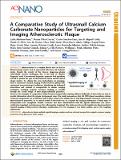Por favor, use este identificador para citar o enlazar a este item:
http://hdl.handle.net/10261/341236COMPARTIR / EXPORTAR:
 SHARE SHARE
 CORE
BASE CORE
BASE
|
|
| Visualizar otros formatos: MARC | Dublin Core | RDF | ORE | MODS | METS | DIDL | DATACITE | |

| Título: | A Comparative Study of Ultrasmall Calcium Carbonate Nanoparticles for Targeting and Imaging Atherosclerotic Plaque |
Autor: | Martínez-Parra, Lydia; Piñol-Cancer, Marina; Sanchez-Cano, Carlos; Miguel-Coello, Ana Beatriz; Di Silvio, Desiré; Gómez, Ana M. CSIC ORCID ; Uriel, Clara CSIC ORCID ; Plaza-García, S.; Gallego, M.; Pazos, Raquel; Groult, Hugo; Jeannin, Marc; Geraki, Kalotina; Fernández-Méndez, Laura; Urkola-Arsuaga, Ainhize; Sánchez-Guisado, Mª Jesús; Carrillo-Romero, Juliana; Parak, Wolfgang J.; Prato, Maurizio; Herranz, Fernando CSIC ORCID CVN ; Ruíz-Cabello, Jesús; Carregal-Romero, Susana | Palabras clave: | Atherosclerosis ligand-mediated targeted imaging amorphous calcium carbonate nanoparticles magnetic resonance imaging synchrotron X-ray fluorescence tissue analysis |
Fecha de publicación: | 2023 | Editor: | American Chemical Society | Citación: | ACS Nano 17: 13811- 13825 (2023) | Resumen: | therosclerosis is a complex disease that can lead to life-threatening events, such as myocardial infarction and ischemic stroke. Despite the severity of this disease, diagnosing plaque vulnerability remains challenging due to the lack of effective diagnostic tools. Conventional diagnostic protocols lack specificity and fail to predict the type of atherosclerotic lesion and the risk of plaque rupture. To address this issue, technologies are emerging, such as noninvasive medical imaging of atherosclerotic plaque with customized nanotechnological solutions. Modulating the biological interactions and contrast of nanoparticles in various imaging techniques, including magnetic resonance imaging, is possible through the careful design of their physicochemical properties. However, few examples of comparative studies between nanoparticles targeting different hallmarks of atherosclerosis exist to provide information about the plaque development stage. Our work demonstrates that Gd (III)-doped amorphous calcium carbonate nanoparticles are an effective tool for these comparative studies due to their high magnetic resonance contrast and physicochemical properties. In an animal model of atherosclerosis, we compare the imaging performance of three types of nanoparticles: bare amorphous calcium carbonate and those functionalized with the ligands alendronate (for micro- calcification targeting) and trimannose (for inflammation targeting). Our study provides useful insights into ligand-mediated targeted imaging of atherosclerosis through a combination of in vivo imaging, ex vivo tissue analysis, and in vitro targeting experiments. | Versión del editor: | http://dx.doi.org/10.1021/acsnano.3c03523 | URI: | http://hdl.handle.net/10261/341236 | DOI: | 10.1021/acsnano.3c03523 | Identificadores: | doi: 10.1021/acsnano.3c03523 issn: 1936-086X |
| Aparece en las colecciones: | (IQOG) Artículos (IQM) Artículos |
Ficheros en este ítem:
| Fichero | Descripción | Tamaño | Formato | |
|---|---|---|---|---|
| ACS Nano 2023.pdf | Artículo principal | 7,94 MB | Adobe PDF |  Visualizar/Abrir |
CORE Recommender
SCOPUSTM
Citations
1
checked on 30-abr-2024
Page view(s)
42
checked on 07-may-2024
Download(s)
6
checked on 07-may-2024
Google ScholarTM
Check
Altmetric
Altmetric
NOTA: Los ítems de Digital.CSIC están protegidos por copyright, con todos los derechos reservados, a menos que se indique lo contrario.
